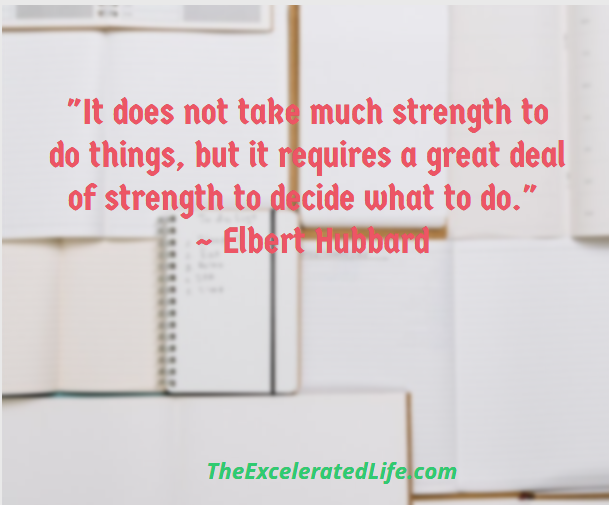Excelerated Productivity™ involves improving efficiency AND effectiveness, not only getting more things done but getting more of the important things done. It requires the realization and acceptance that we can’t do everything – even the important stuff – so we must concentrate and focus on the highest priority tasks.
TheExceleratedLife.com
Title Photo by Direct Media on StockSnap
What’s Important Now?
It’s 9:00 on Monday morning. I have a number of activities I want to work on.
- I need to finish the first draft of this week’s newsletter and blog article.
- I want to send book cover examples to my newsletter mailing list and ask them to vote on their favorite.
- I’m writing papers on each of the Excelerated Life™ principles. I’m currently working on Valid Values and I want to get the draft of that done this week.
- I need to replace the batteries in our smoke detectors which I do when the time change occurs.
- I have a couple of e-mails to send related to church activities in which I’m involved.
- I’m behind with blog posts and want to work on getting an old article posted.
- I have several worksheets to complete to earn the CE credits I need to renew my BCC certification next February.
- I have a 10:30 AM appointment.
Do you see my concern? How do I select which of these tasks to work on? What’s important right now?
What’s Important?
In order to decide “what’s important now”, we first have to know what’s important. In his book, Getting Things Done, David Allen suggests looking at our lives, dreams, and goals from various levels as if we were looking out the windows from different floors in a building.
Early in my career as a software developer, I worked in downtown Greenville at the Daniel Building, aka the Fluor Daniel Building. At 25 stories, it was and is the tallest building in Greenville, SC. Imagine you were looking out of this building at your own life.
From the top floor, you see your life’s purpose – the core definition for your life and work.
Walk down to the 20th floor and look out. Here you can view the dream or vision of what you want to achieve in 3 to 5 years.
On the 15th floor, you look out and see your long-term goals, from 1 to 3 years.
Go down to the 10th floor and look out at your roles and short-term goals. These are the key areas where you want to achieve results in the next 3 to 6 months.
Down on the 5th floor, you can see your short-term projects and your weekly plans.
Finally, you get to the ground floor. Here you look out to see what’s important now, today’s tasks, errands, e-mails, and phone calls.

Dreams –> Goals –> Steps
OK, so you’ve gazed out the windows from various floors or perspectives and have your vision for your purpose, your dreams for achieving your purpose, and your long- and short-term goals. How do you break these down into actionable steps?
One good way is to use the Stepladder model from Stick With It. In this model, you start with your dreams. A dream is something you’ve never done before, which will take more than 1 year, perhaps 3 to 5 years or longer. (As you can see, these time limits vary from the earlier example. Simply work with what feels natural to you.)
Break your dreams into long-term goals, 6 months to a year. Break your long-term goals into short-term goals of 3 to 6 months. Now, break the short-term goals into steps, something you can do in a day, usually from 10 min to an hour.
Another way to develop your steps is to use a 7 X 7 action plan. This can be helpful if you have trouble breaking a goal into bite-size steps. Take a short-term goal and divide it into seven steps. Now, break each of those seven steps into seven smaller steps. You now have 49 steps needed to achieve the goal. (And if any of them are still too large, turn them into seven more steps.)
What Do I Do Now?
Once you decide what’s important, what do you do now? How do you know which of all the important things is the most important? In other words, how do you prioritize?
Here are a few ideas from Oliver Burkeman’s Four Thousand Weeks: Time Management For Mortals.
- “Adopt a ‘fixed volume’ approach to productivity.” Don’t try to do everything at once – it isn’t possible anyway. Burkeman advises using two lists: the 3 Things list and everything else. The 3 Things list, as the name implies, carries your three most important tasks; you can’t add anything to the 3 Things until you’ve completed or scrapped something on that list. Put everything else on the second list.
- Focus on 1 project at a time (or 1 work project and 1 personal project) and complete it before you start something else. Starting a lot of projects feels like you’re making progress, but it’s like multitasking and actually takes more time in the long run. It’s like taking 1000 steps in random directions vs. 1000 steps in the same direction.
- Practice “strategic underachievement”. Decide in advance what you’ll let go of or where you won’t shine. For example, you may choose to give up a spotless kitchen in order to have more time with your children.
Deciding In The Moment
OK, you’ve identified the important things and prioritized them. You’re all set to get to work. How do you choose what to work on right now? Let’s turn again to Getting Things Done for David Allen’s take on how to decide in the moment.
There are four areas to consider as you make your decision: context, available time, energy level, and priority [Allen]
Context: What can you do where you are, with the tools you have on hand? In my case, I could do any of the items on my list except for going to the appointment later in the morning.
Available time: How much time do you have available before you have to do something else? I have a little less than an hour and a half since I’ll need to leave about 15 minutes prior to my appointment.
Energy level: Pay attention to your ultradian rhythm. This consists of recurrent periods or cycles repeated throughout a 24-hour day of higher and lower energy levels. When your energy is plentiful, pick a task that requires concentration and effort. When your concentration and energy flag, that’s a sign you’re moving to the low energy cycle. Choose a lower energy task that doesn’t require much mental effort. Since I’m just starting my morning, my energy level is quite high. I can put off sending e-mails, changing smoke detector batteries, even the blog posts for a time when I’m not as energetic and alert.
Priority: After you choose from context, available time, and energy level, examine the remaining options and pick the most important one. If you’re unsure, start at the “ground floor” of today’s tasks, errands, e-mails, and phone calls, or look at your stepladder steps. As for my list, I should pick one of the writing tasks or study the BCC recertification material.
Choosing What’s Important Now Leads to Excelerated Productivity™
So, out of my list of tasks, which one did I choose to work on? #1. Finish this week’s newsletter and blog article. In fact, you’re reading it now!
Excelerated Productivity™ involves improving efficiency AND effectiveness, not only getting more things done but getting more of the important things done. It requires the realization and acceptance that we can’t do everything – even the important stuff – so we must concentrate and focus on the highest priority tasks for accomplishing our BIG goals and paying attention to the important people in our lives. That is embracing your Excelerated Life™!
Excelerated Productivity™ — improving efficiency and effectiveness — is one step in creating your Excelerated Life™, a life of flourishing and well-being, and a life of meaning, purpose, and service.
Read more about the Excelerated Life™.
Resources:
Allen, David. Getting Things Done (Revised Edition). New York: Penguin Books, 2015.
Burkeman, Oliver. Four Thousand Weeks: Time Management For Mortals. New York: Farrar, Straus and Giroux, 2021.
Young, Sean D. Stick With It. New York: HarperCollins Publishers Inc., 2017.



One Reply to “What’s Important Now?”